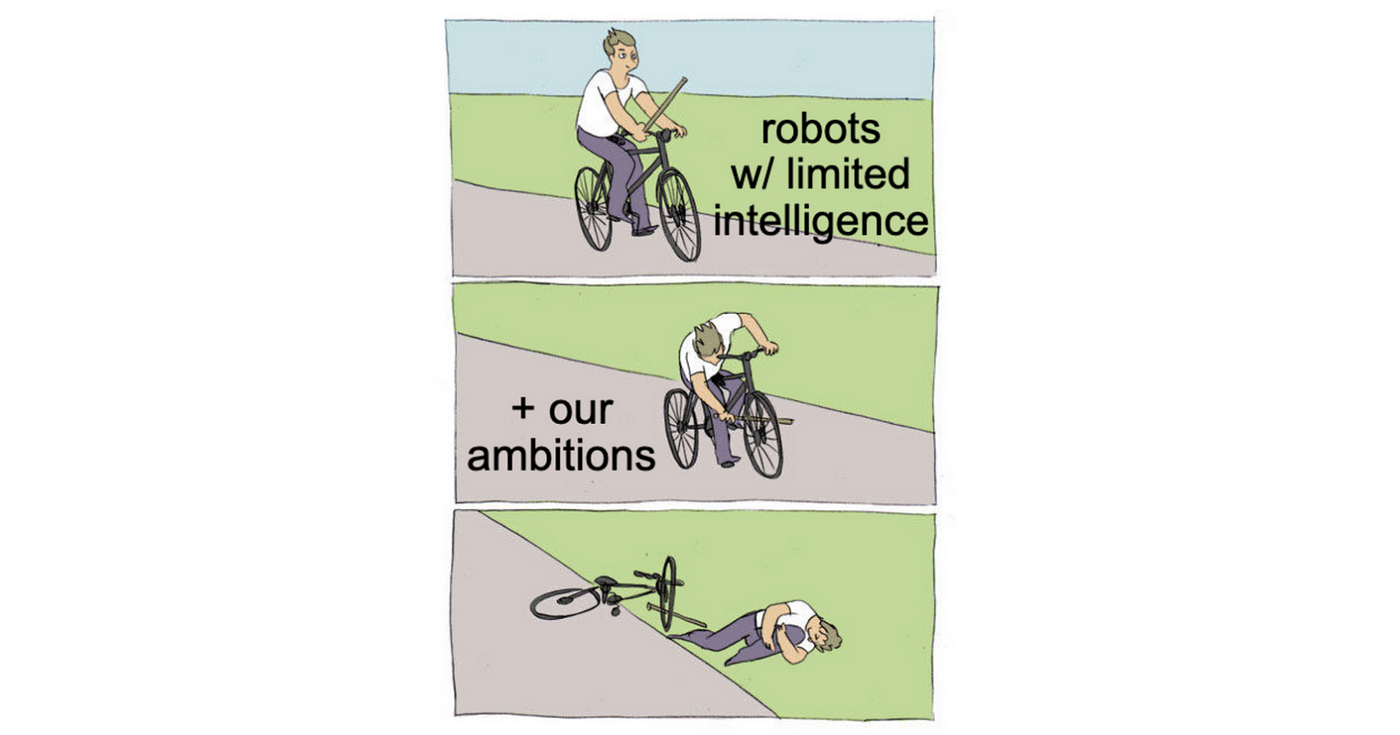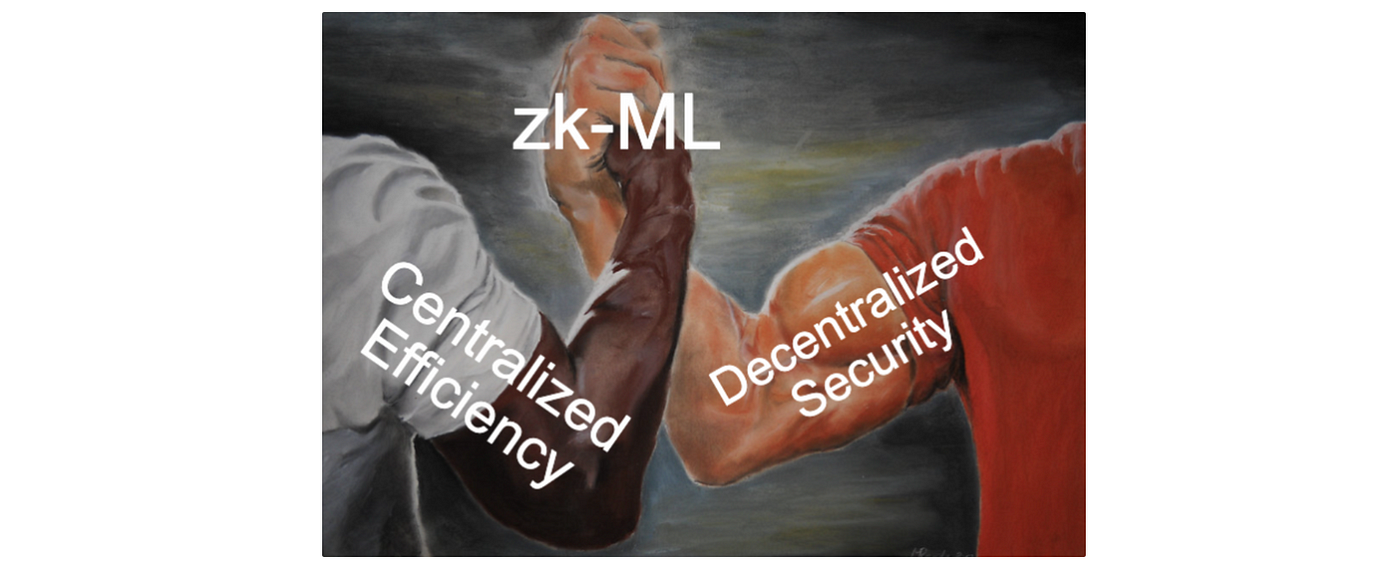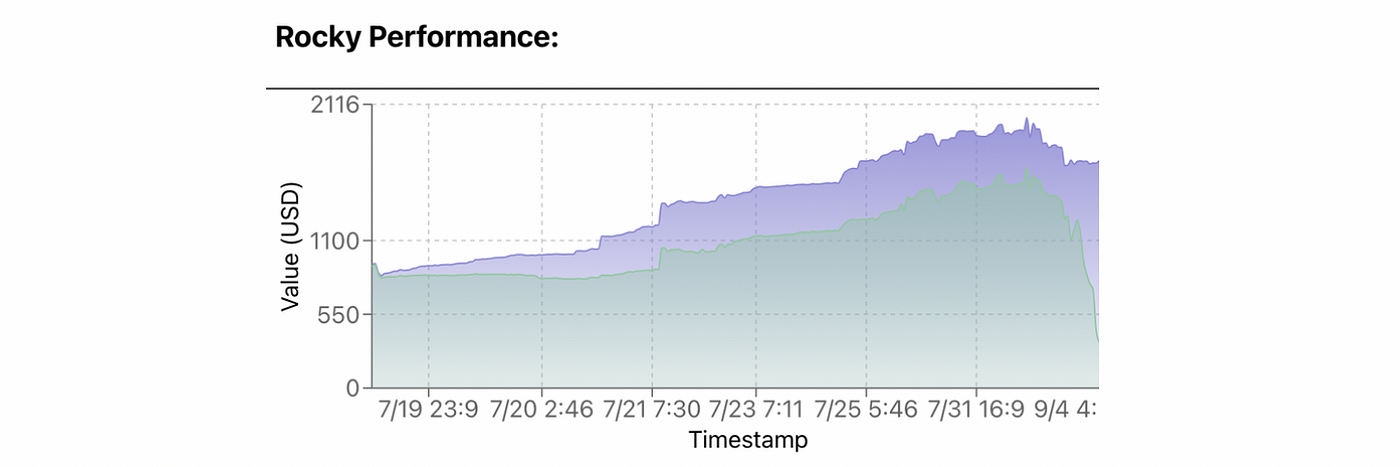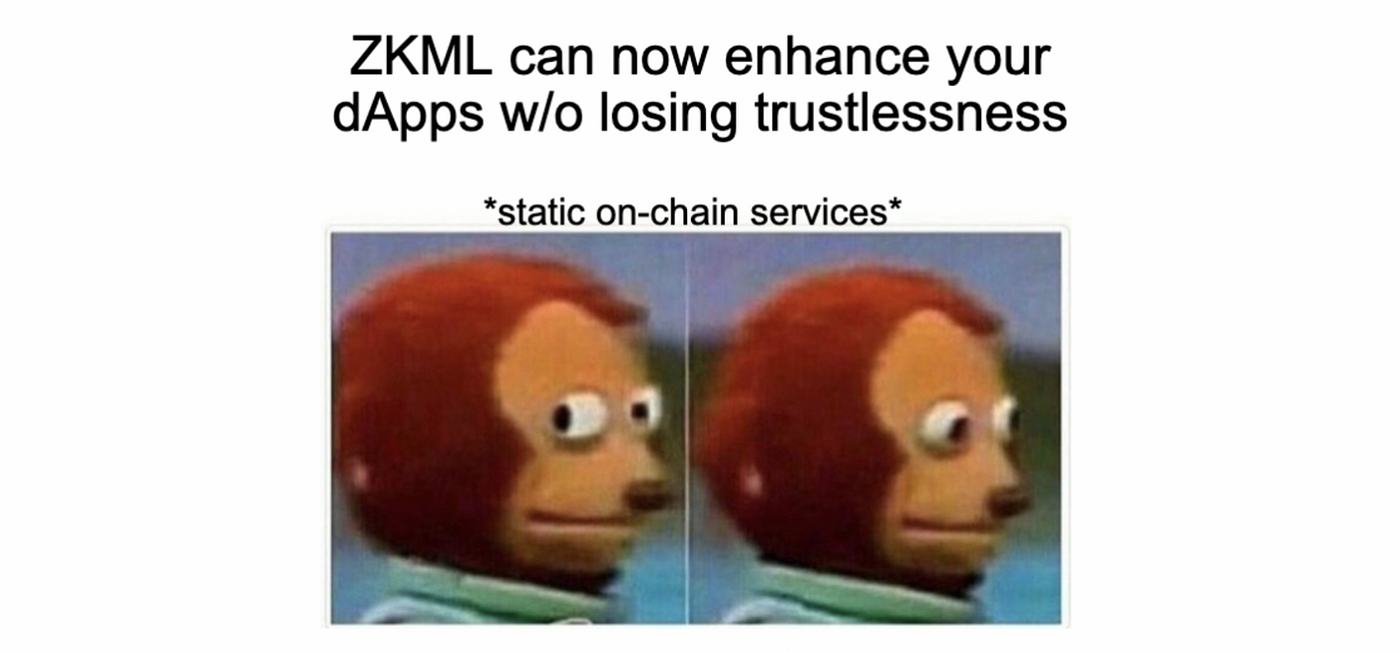
未来AI*区块链=区块链自我进化
https://medium.com/@ModulusLabs/chapter-4-blockchains-that-self-improve-e9716c041f36

Our robots/smart contracts can be so much more…
Smart contracts are the same — our faithful servants, they turn intention into programmatic behavior and trust into execution. And while hack after hack and mistake after mistake has the whole world laughing at the black eye and broken fingernails of web3, we here in the community know:
More than that alone, though: we know that we can do better. After all, we’ve already created a tool that’s fundamentally revolutionized every other industry: leveling up classic bots in those arenas into machines of intelligence.
You’ve probably guessed it — of course, we mean Artificial Intelligence. The one that’s given bots the ability to dance, land, and create. The one that, well, we don’t have in web3.
And that’s why we started Modulus Labs. We know that AI — verified on-chain and used for the benefit of the chain — will fundamentally change the decentralized world. In fact, in the weeks following the launch of our Rockefeller bot (rockybot.app), we’ve already connected with dozens of protocols ready to upgrade with trustless inference.
Which all begs the question:
Why does verifying AI results matter for web3? And, of course, who actually cares?
To that end, we wanted to take a short break from our regular programming of next gen zero-knowledge prover research (more on this coming soon? You betcha…) and, instead, lay out our latest thoughts on the future of on-chain intelligence.

No shame in it, we’ve all been there…
In order to out-compete web2 counterparts & expand offerings, dApps, DeFi, NFTs and the greater web3 ecosystem must incorporate AI features. The end point will be blockchains which intelligently edit themselves, beating out static rivals.
Let’s get into it!
First, a quick recap: trustless intelligence follows the paradigm of zk-rollups.
These pioneering services are solving the Ethereum bandwidth challenge through the use of SNARKs/STARKs (see StarkNet, zkSync, and Polygon Hermez, among many others). This means proving generalized computation off-chain in sophisticated proof systems, then bundling those proofs for fast verification on-chain. Critically, this method attains a remarkably high level of cryptographic security, achieving scale without sacrificing a huge tenant of the web3 value prop.
The mechanism for trustless intelligence is extremely similar: pump an AI model’s parameters and inputs through an efficient zk-proof system, before verifying the proof of that inference and subsequently accepting the result, all on-chain. This allows us to:
The consequence of this system is clear:

zk machine learning: ultimate marriage of powerful central compute and the new ethos of decentralization
Although this is the same layout we proposed months ago, much has changed in the landscape.
And the change that has us most excited? Signals that we’re just now uncovering an enormous and growing demand for trustless intelligence — here’s where our confidence comes from…
To say that Rocky punched well above his weight class would be, well, quite the under-statement.
For what amounted to the simplest possible neural network making slightly better than random predictions for Eth future exchange rates, hundreds of excited fans ended up donating to our silly proof of concept (you can take a look at Rocky’s contribution leaderboard for yourself) — so much so that we’ve since shut down donations and forced Rocky to trade away the last of his gas allowance.

Rocky’s historic trade performance, before selling nearly all of his Eth post-merge
More than engagement from the community alone, however, were dozens of real web3 projects reaching out to us. Their reaction? Sheer astonishment at the apparent reality of trustless intelligence — today.
We thought we’d highlight a few projects we’ve been particularly engaged with:
Project 1: Lyra Finance — Lyra, at its core, is a suite of smart contracts which forms an automated market maker for trading ERC-20 options. Delivering one of the best user experiences in the space, the Lyra Protocol brings the derivatives market to the Ethereum blockchain. Among other things, the service represents a deeply impressive feat of incentive and user design.
What can we say… we’re big fans.

Lyra is the most complete decentralized crypto options trading protocol built on Ethereum
While Lyra has already delivered wildly impressive returns for their LPs — posting a positive return even during recent downturns in the markets — their team is always interested in increasing capital efficiency (the lifeblood of any options protocol). That’s why we’re excited to announce that, in the coming months, we’ll be working closely with Lyra to enhance their AMM with intelligent features.
Project 2: Astraly — Astraly is a reputation-based token distribution platform built on StarkNet. The team has created a home for tens of thousands of users interested in finding and supporting the latest and greatest StarkNet projects. Their insight? Use reputation to combat the hyper-financialized token distribution schemes that dominate the web3 space.

Astraly is a leading reputation-based token distribution platform
It’s clever, and projects like briqNFT and Influence have already used the Astraly platform to build successful followings. It’s clear that reputation labeling and management are emerging as key features for many web3 services.
As many of you are no doubt thinking, however, reputation is no easy thing to measure. And as is so often the case for any complex metric: the more comprehensive and diverse the input, the better the result. That’s why we’ll be working with the Astraly team to create an AI-based reputation system (using clustering models to identify user/project traits, badges, and historic behaviors before trustlessly calculating reputation ratings).
Project 3: Aztec Protocol (and other privacy-preserving services) — the Aztec Network is the “privacy layer for web3”, i.e. a privacy-focused L2 built atop Ethereum. Aztec’s core features all revolve around the ability for users to confidentially interact with DeFi services. In other words, Aztec aims to be the privacy-by-default platform for all things web3, be it DeFi, NFTs, or gaming.
To those amongst you who are more plugged into the space, of course, you’ll know exactly where this is heading:
The Treasury Department’s (OFAC) sanctions against TornadoCash — effectively banning the decentralized crypto-mixing service — has sent shivers throughout the privacy crypto landscape. For the first time ever, the government has explicitly and publicly banned a neutral privacy tool on the internet. Specifically, the Treasury Department explains:
“Despite public assurances otherwise, Tornado Cash has repeatedly failed to impose effective controls designed to stop it from laundering funds for malicious cyber actors on a regular basis and without basic measures to address its risks. Treasury will continue to aggressively pursue actions against mixers that launder virtual currency for criminals and those who assist them”
This is a problem for Aztec and their peers. Beyond chilling effects alone, Aztec is now forced to put in practices that fundamentally reduce the core capabilities of their service (lower speeds, install tx limits, etc.). That is, unless we can use trustless AI to create compliance features for the privacy protocol at the contract level. To that end, we are now working on the technical breakthroughs needed for contract-level compliance tools using ML.
For us, the use-cases above (and some early customers we’re excited to announce soon!) capture our first instincts around the kind of things AI could do for on-chain projects. To quickly summarize:
Lyra represents one of the first major arenas for massive on-chain AI use cases:
Fair & Trustless Matchmaking: we can fairly and transparently deliver higher returns/value for market participants by enhancing on-chain markets with AI features, while not taking on additional trust assumptions.
Astraly, on the other hands, demonstrates:
Fair & Trustless Personalization: using on+off-chain data, we can now compute complex metrics while guaranteeing fairness. This ultimately results in massively improved UX and greatly increased trust between users and the service.
And finally, privacy protocols serve up the inspiring possibility that with AI, we can now conduct:
Fair & Trustless Identity Authentication: protocols can now access advanced authentication schemas using ML, including image-based KYC at the contract level to confirm identity / prove compliance.
Taken together: AI, verified by the chain and for the chain, fundamentally reinforces and enhances the core value prop of any decentralized service — by making that service better in all the ways intelligence can.
This is echoed across each of the opportunities above, where AI is both enhancing and expanding core service features. And that’s really just the first step:
Combined with others’ work in model robustness and explainability, a natural marriage, web3 services with intelligence will simply be better.

The fact is: better is just, better
Finally, as promised, a small teaser for our upcoming whitepaper. As many of you know, we’ve been researching different proof systems that could support the future of verifiable inference. And while we’re not quite ready yet to share our findings with the world, we thought we’d end today’s blog with some technical signals:
It’s impossible to stay mad at him!
We say yes. Or at the very least, we should give them another chance.
But this time, we’ll make sure to give them the ability to help themselves first — finally equipping them with intelligence beyond ourselves.
After all, a robot that self-improves is ultimately, a better bot.
零知识机器学习(ZKML)是最近在密码学界掀起波澜的一个研发领域。但它是什么,为什么有用? zklog观察到从去年底的ZK Symposium上Ethereum Foundation和scroll邀请了Jason Morton from EZKL,Ryan Cao from Modulus Labs等做的相关主题研讨,目前持续在web3领域升温。
最近我们花几期专门介绍ZKML。本篇主要为 Modulus Labs对ZKML的相关研究。以下Modulus Labs简称为“我们”。
引言
智能合约是我们忠实的仆人,也是契约社会忠实的警察,它们将意图转化为程序化行为,将信任转化为执行。虽然一次又一次的黑客攻击和一个又一个的错误让全世界都在嘲笑web3 的黑眼圈和破损的指甲,但我们在社区中知道:这不是机器人的错
然而,不仅如此:我们知道我们可以做得更好。毕竟,我们已经创建了一种从根本上彻底改变所有其他行业的工具:将这些领域的经典机器人升级为智能机器。
您可能已经猜到了——当然,我们指的是人工智能。赋予机器人跳舞、着陆和创造能力的机器人。这在 web3 中是没有的。
这就是创立 Modulus Labs 的原因。我们知道,人工智能——在链上验证并用于链的利益——将从根本上改变去中心化的世界。事实上,在我们的洛克菲勒机器人 (rockybot.app) 推出后的几周内,我们已经连接了数十个准备通过无信任推理进行升级的协议。
这一切都引出了一个问题:
为什么验证 AI 结果对 web3 很重要?而且,当然,谁真正关心?
为此,我们想从我们对下一代零知识证明者研究的常规编程中短暂休息一下,而是提出我们对链上未来的最新想法智力。

为了在竞争中胜过 web2 对手并扩展产品,dApp、DeFi、NFT 和更大的 web3 生态系统必须包含 AI 功能。终点将是智能编辑自己的区块链,击败静态竞争对手。
**定义:**实际
无需信任的智能和经过 zk 验证的 AI 推理的
含义
来自今天的信号:
来自早期客户/合作伙伴对话的案例研究
未来
:建立具有远见、思想和自主性的可信赖链
接下来是什么:
比最先进的技术快十倍以上的证明系统
首先,快速回顾一下:无需信任的智能遵循 zk-rollups 的范式。
这些开创性服务正在通过使用 SNARKs/STARKs解决以太坊带宽挑战。这意味着在复杂的证明系统中证明链下的*广义计算,然后捆绑这些证明以在链上进行快速验证。*至关重要的是,这种方法获得了非常高的加密安全级别,在不牺牲 web3 价值支柱的巨大租户的情况下实现了规模化。
去信任智能的机制非常相似:通过高效的 zk 证明系统泵送 AI 模型的参数和输入,然后验证该推理的证明并随后接受结果,所有这些都在链上。这使我们能够:
该系统的结果很明显:

zkML:强大的中央计算与去中心化的新精神的最终结合
虽然这与我们几个月前提出的布局相同,但格局已经发生了很大变化。
最令我们兴奋的变化是什么?信号表明我们刚刚发现对不信任情报的巨大且不断增长的需求——这就是我们信心的来源……
要说Rocky 的拳击远高于他的体重级别,那是轻描淡写的说法。
对于 Eth 未来汇率的随机预测,这相当于最简单的神经网络,比随机预测略好一些,数百名兴奋的粉丝最终为我们愚蠢的概念证明捐款(你可以自己看看Rocky 的贡献排行榜)——这么多所以我们已经停止了捐赠,并迫使洛基用掉他最后的汽油津贴。

Rocky 历史性的交易表现,在合并后几乎卖掉了他所有的 Eth
然而,不仅仅是来自社区的参与,还有数十个真正的 web3 项目向我们伸出了援手。他们的反应?对无需信任的情报的明显现实感到非常惊讶——今天。
我们认为我们会强调一些我们特别参与的项目:
项目 1:Lyra Finance ——Lyra 的核心是一套智能合约,它构成了一个用于交易 ERC-20 期权的自动化做市商。Lyra 协议提供了该领域最好的用户体验之一,将衍生品市场带入了以太坊区块链。除其他外,该服务代表了令人印象深刻的激励和用户设计壮举。
我们能说什么……我们是超级粉丝。

Lyra 是建立在以太坊上最完整的去中心化加密期权交易协议
虽然 Lyra 已经为他们的有限合伙人带来了令人印象深刻的回报——即使在最近的市场低迷时期也取得了积极的回报——他们的团队始终对提高资本效率(任何期权协议的命脉)感兴趣。这就是为什么我们很高兴地宣布,在接下来的几个月里,我们将与 Lyra 密切合作,通过智能功能增强他们的 AMM。
项目二:Astraly ——Astraly 是一个建立在 StarkNet 上的基于信誉的代币分发平台。该团队为数以万计有兴趣寻找和支持最新和最伟大的 StarkNet 项目的用户创建了一个家。他们的洞察力?使用声誉来对抗主导 web3 空间的超金融化代币分配方案。

Astraly 是领先的基于声誉的代币分发平台
它很聪明,像briqNFT和Influence这样的项目已经使用 Astraly 平台建立了成功的追随者。很明显,声誉标签和管理正在成为许多 web3 服务的关键特性。
然而,正如你们中的许多人无疑在想的那样,声誉并不是一件容易衡量的事情。就像任何复杂指标经常出现的情况一样:输入越全面和多样化,结果就越好。这就是为什么我们将与 Astraly 团队合作创建一个基于 AI 的信誉系统(在不信任地计算信誉评级之前使用聚类模型来识别用户/项目特征、徽章和历史行为)。
项目 3:Aztec 协议(和其他隐私保护服务)——Aztec 网络是“web3 的隐私层”,即建立在以太坊之上的以隐私为中心的 L2。Aztec 的核心功能都围绕着用户与 DeFi 服务进行保密交互的能力。换句话说,Aztec 的目标是成为所有 web3 事物的默认隐私平台,无论是 DeFi、NFT 还是游戏。
当然,对于那些更热衷于这个领域的人来说,你会确切地知道它的发展方向: